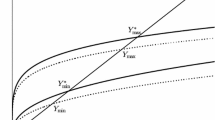Abstract
“Bang-bang” investment in a two-sector growth model with immobile capital is “rational” and leads to a unique and globally stable long-run equilibrium along a “sliding trajectory.” This steady state coincides with the stationary equilibrium in the traditional model with non-sector-specific capital.
Similar content being viewed by others
References
Benhabib, J., and Jovanovich, B. (1991): “Externalities and Growth Accounting.”American Economic Review 81: 82–113.
Bosch, A., Mas-Colell, A., and Razin, A. (1973): “Instantaneous and Noninstantaneous Adjustment to Equilibrium in Two-Sector Growth Models.”Metroeconomica 25: 105–118.
Davis, S. J. (1987): “Allocative Disturbances and Specific Capital in Real Business Cycles Theories.”American Economic Review, Papers and Proceedings 77: 326–332.
Diamond, P. A. (1965): “National Debt in a Neoclassical Growth Model.”American Economic Review 55: 1126–1150.
Drandakis, E. M. (1963): “Factor Substitution in the Two-Sector Growth Model.”Review of Economic Studies 38: 217–228.
Eckwert, B., and Schittko, U. K. (1988): “Disequilibrium Dynamics.”Scandinavian Journal of Economics 90: 189–209.
Filippov, A. F. (1960): “Differential Equations with Discontinuous Right-hand Side.”Matematicheskii Sbornik 51: 99–128. [English translation:American Mathematical Society Translations, Series 2 42 (1964): 199–231.]
Gale, D., and Nikaido, H. (1965): “The Jacobian Matrix and Global Univalence of Mappings.”Mathematische Annalen 159: 81–93.
Ginsburgh, V., Henin, P. Y., and Michel, P. (1985): “A Dual Decision Approach to Disequilibrium Growth.”Oxford Economic Papers 37: 353–361.
Harberger, A. C. (1962): “The Incidence of the Corporation Income Tax.”Journal of Political Economy 70: 215–240.
Honkapohja, S., and Ito, T. (1982): “Disequilibrium Dynamics with Monetarist Price Expectations.”Economics Letters 9: 69–75.
— (1983): “Stability with Regime Switching.”Journal of Economic Theory 29: 22–48.
Inada, K. (1966): “Investment in Fixed Capital and the Stability of Growth Equilibrium.”Review of Economic Studies 33: 19–30.
Ito, T. (1978): “A Note on Disequilibrium Growth Theory.”Economics Letters 1: 45–49.
— (1980): “Disequilibrium Growth Theory.”Journal of Economic Theory 23: 380–409.
Kaldor, N. (1956): “Alternative Theories of Distribution.”Review of Economic Studies 23: 83–100.
Kemp, M. C., and Jones, R. W. (1962): “Variable Labor Supply and the Theory of International Trade.”Journal of Political Economy 70: 30–36.
Kurz, M. (1963): “A Two-Sector Extension of Swan's Model of Economic Growth: The Case of No Technical Change.”International Economic Review 4: 68–79.
— (1968): “The General Instability of a Class of Competitive Growth Processes.”Review of Economic Studies 35: 155–174.
Mankiw, N. G., Romer, D., and Weil, D. N. (1992): “A Contribution to the Empirics of Economic Growth.”Quarterly Journal of Economics 107: 407–437.
Marrewijk, C. van, and Verbeek, J. (1993): “Disequilibrium Growth Theory in an International Perspective.”Oxford Economic Papers (forthcoming).
Meade, J. E. (1962):A Neoclassical Theory of Economic Growth. London: Allen & Unwin. [2nd edition.]
Neary, J. P. (1978): “Short-run Capital Specificity and the Pure Theory of International Trade.”Economic Journal 88: 488–510.
O'Rourke, K. (1989): “Tariffs and the Current Account with Short-run Capital Specificity.”Economics Letters 30: 67–70.
Pasinetti, L. L. (1962): “The Rate of Profit and Income Distribution in Relation to the Rate of Economic Growth.”Review of Economic Studies 29: 267–279.
Picard, P. (1983): “Inflation and Growth in a Disequilibrium Macroeconomic Model.”Journal of Economic Theory 30: 266–295.
Robinson, J. (1956):The Accumulation of Capital. London: MacMillan.
Ryder, H. E. (1969): “Optimal Accumulation in a Two-Sector Neoclassical Economy with Non-shiftable Capital.”Journal of Political Economy 77: 665–683.
Schittko, U. K., and Eckwert, B. (1985): “Dynamic Aspects in a Temporary Equilibrium Model of International Trade with Quantity Rationing.”European Journal of Political Economy 1: 189–220.
Solow, R. M. (1956): “A Contribution to the Theory of Economic Growth.”Quarterly Journal of Economics 70: 65–94.
Uzawa, H. (1961): “On a Two-Sector Model of Economic Growth.”Review of Economic Studies 78: 40–47.
Author information
Authors and Affiliations
Additional information
This article was written while the authors were visiting scholars at Cornell University. We gratefully acknowledge financial assistance from the Erasmus University Trust Fund and the Netherlands Scientific Organization. We would like to thank, without implicating, two anonymous referees, Martijn Herrmann, Jean-Marie Viaene, Claus Weddepohl, and the participants of seminars at the University of Maryland, the University of Montreal, and Erasmus University Rotterdam for perceptive remarks and useful comments. Jeroen Hinloopen and Rien Wagenvoort provided able graphical assistance. The views expressed in this article are those of the authors and not necessarily those of the World Bank.
Rights and permissions
About this article
Cite this article
van Marrewijk, C., Verbeek, J. Sector-specific capital, “Bang-bang” investment, and the Filippov solution. Zeitschrift für Nationalökonomie 57, 131–146 (1993). https://doi.org/10.1007/BF01237411
Received:
Revised:
Issue Date:
DOI: https://doi.org/10.1007/BF01237411



